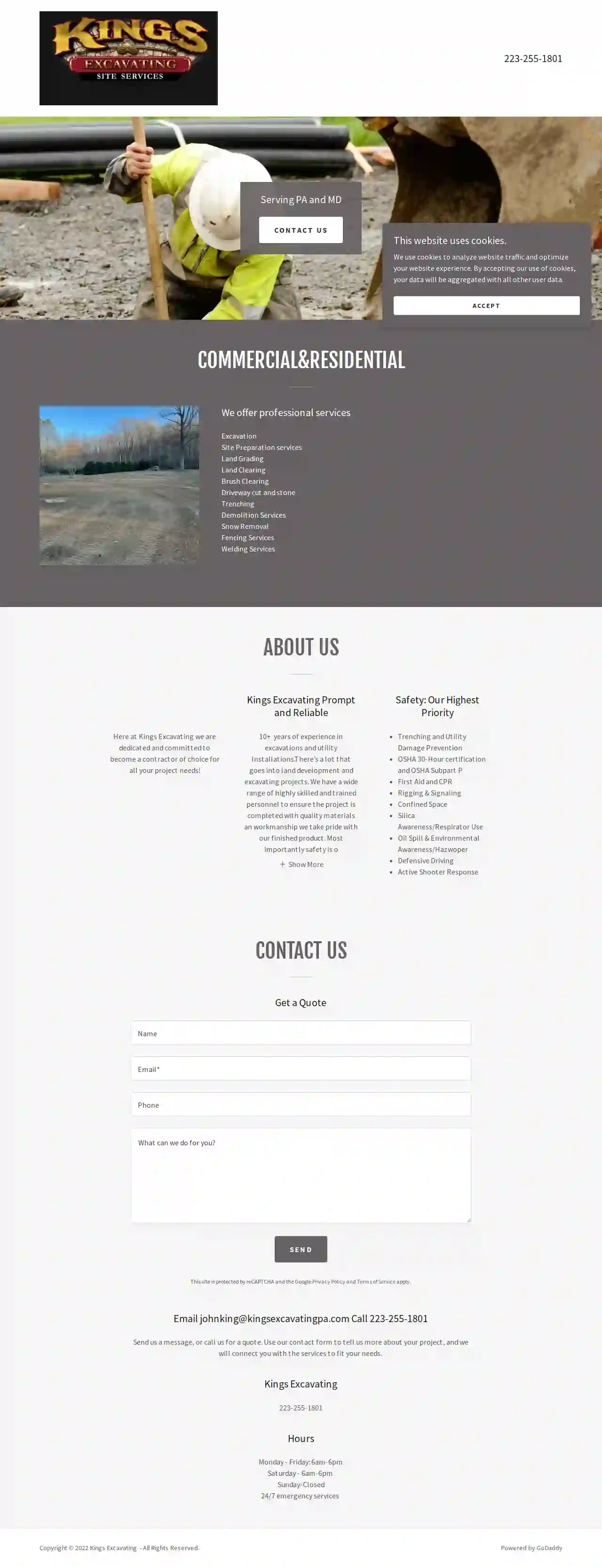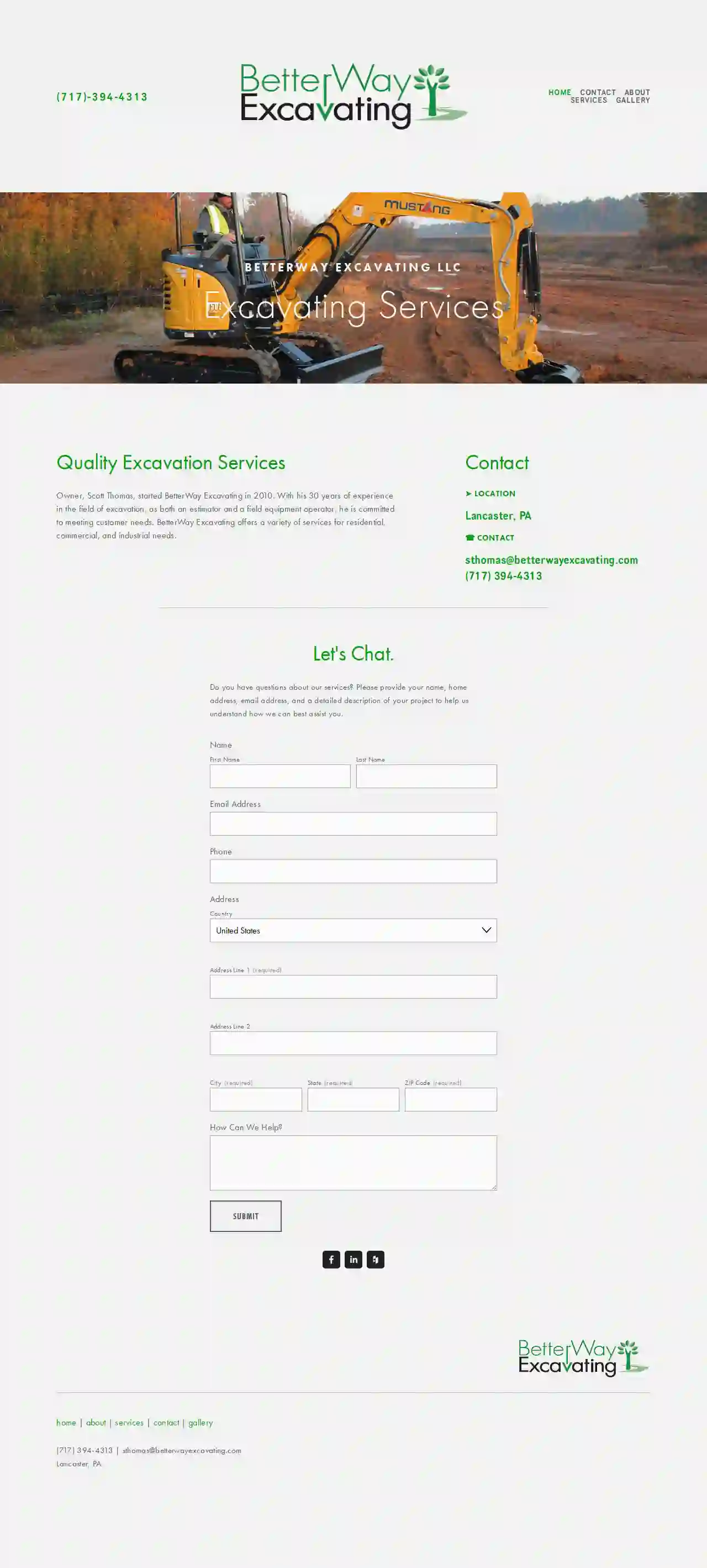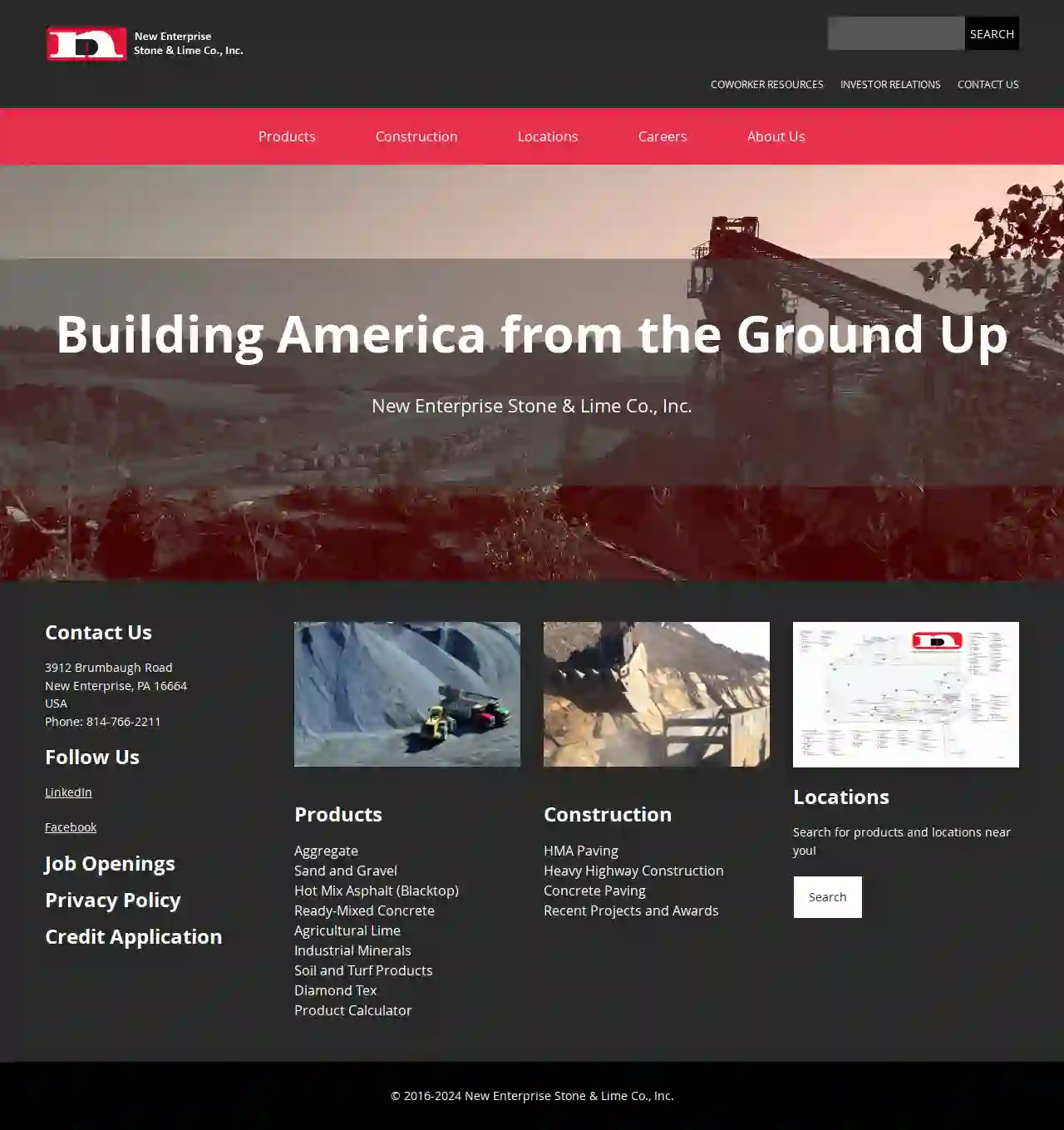Excavation Contractors Ardmore
Find top Excavation Contractors Near Me in Ardmore
Get 3 FREE Digging Contractors quotes for your project today! Compare profiles, reviews, accreditations, portfolio, etc... and choose the best service.

Kings Excavating
Pittsburgh, USKings Excavating: Prompt and Reliable Here at Kings Excavating, we are dedicated and committed to becoming your contractor of choice for all your project needs! With over 10 years of experience in excavations and utility installations, we have a wide range of highly skilled and trained personnel to ensure your project is completed with quality materials and workmanship. We take pride in our finished product, and most importantly, safety is our number one priority. We strive to create a safe working environment for our employees and the public throughout every project. Safety: Our Highest Priority We prioritize safety in all our operations, adhering to the highest industry standards. Our team is equipped with the necessary certifications and training to ensure a safe and efficient work environment. Our commitment to safety includes: Trenching and Utility Damage Prevention OSHA 30-Hour certification and OSHA Subpart P First Aid and CPR Rigging & Signaling Confined Space Silica Awareness/Respirator Use Oil Spill & Environmental Awareness/Hazwoper Defensive Driving Active Shooter Response
- Services
- Why Us?
- Gallery
Get Quote
Staten Island Masonry- Staten Island Masonry Contractors
518 reviewsYork, USStaten Island Masonry Serving Staten Island and surrounding areas Staten Island Masonry and Concrete is the premier choice for masonry and concrete services in Staten Island. Our team of experienced masonry contractors specialize in a variety of services, including brick laying, block laying, and concrete work. We have been providing superior quality masonry and concrete services to Staten Island and the surrounding areas for over 20 years. We are committed to providing outstanding customer service and craftsmanship on every project. Our team is dedicated to providing the highest quality standard of work and strive to exceed our customers’ expectations. We take the time to understand your project and provide a tailored solution that meets your needs.
- Services
- Why Us?
- Testimonials
- Gallery
Get Quote
Weaver & Sons Excavation
55 reviews5147 Ore Bank Road East, York, 17406, USThe clear choice for all your excavation needs. These are our original pieces of equipment. While we have greatly expanded our fleet to address our clients' needs, our motto is still the same: "We want the small jobs the big guys don't want." SERVICES With over 30 years of experience in excavation and general construction, we can help you design a solution that meets your needs at a very reasonable cost. ABOUT Weaver and Sons Excavation started in 2007 when Mark Weaver closed his general construction business after 20 years. He decided to keep his excavation equipment and continue on as a part-time business. Eventually, business was good enough that he decided to go full-time. After going full-time, the Weaver and Sons office was relocated to a 200-year-old town hall building in Wrightsville that Mark personally renovated. We have since added a new shop and office in Hellam, York County. Mark's experience of over 30+ in the general construction business gives him the unique ability to advise on all phases of your project, as well as the excavation phase. Weaver and Sons can provide references from past residential clients, as well as numerous commercial contractors that use them regularly. Our mission is simple: Get in, get out, and leave a happy customer!
- Services
- Why Us?
- Our Team
- Gallery
Get Quote
Central Penn. Excavating llc
51 reviewsHarrisburg, USYour Trusted Partner in Excavation and Site Preparation At Central Penn Excavating, we specialize in delivering top-quality excavation, land clearing, tree removal, hardscaping, and concrete services across Pennsylvania. Whether you're preparing a site for construction, enhancing your landscape, or removing hazardous trees, our experienced team is here to ensure your project is completed with precision, safety, and excellence. Let us lay the groundwork for your success with reliable, professional service you can count on. Our Story: Building Strong Foundations for Pennsylvania Central Penn Excavating was founded with a commitment to delivering exceptional service and quality in every project we undertake. As a locally owned and operated company, we pride ourselves on our deep roots in the Pennsylvania community and our dedication to helping our neighbors achieve their goals. From humble beginnings, we have grown into a trusted name in excavation, land clearing, and site preparation, known for our reliability, professionalism, and attention to detail.
- Services
- Why Us?
- Gallery
Get Quote
David H. Martin Excavating, Inc.
4.350 reviews4961 Cumberland Highway, Chambersburg, 17202, USYour Complete Excavating Solution Your projects deserve a reliable partner in delivering highly trained and trusted excavation solutions for jobs of any size. Our highly trained team is equipped with the skills and capabilities designed for residential homeowners to commercial project managers. Excellence & Integrity We understand the frustrations that arise with extended project completion dates, unexpected costs, and uncommunicative teams. Excellence and integrity are at the core of everything we do—it’s not just what we do, but the foundation for all that we are. Expect your project to be completed and on time—everytime.
- Services
- Why Us?
- Our Team
- Testimonials
Get Quote
Kirby Kitner Excavating & Paving
4.86 reviews7214 Spring Road, New Bloomfield, USWelcome to Kirby Kitner Excavating! Whether it is site prep for new structures, foundations, road building, graves sites, drainage or septic systems, Kirby consults with all customers personally and is present on all job sites to assure you of quality workmanship. Our staff is professional, experienced, and dependable. We are celebrating our 39th year in business. Kirby Kitner Excavating is a local, family-owned business. Our company is fully insured and we give free estimates. Kirby Kitner Excavating is a DOT Registered Motor Carrier: USDOT 2291670 and a Registered PA Contractor: # PA027056. We are members of the Perry County Chamber of Commerce. Kirby Kitner Excavating is located at 7214 Spring Road, New Bloomfield, PA.
- Services
- Why Us?
- Gallery
Get Quote
BetterWay Excavating
4.97 reviewsLancaster, USBetterWay Excavating LLC BetterWay Excavating LLC is a family-owned and operated business that has been serving the Lancaster, PA area since 2010. Owner, Scott Thomas, brings over 30 years of experience in the field of excavation, both as an estimator and a field equipment operator. He is committed to providing quality services to his customers and meeting their needs. BetterWay Excavating offers a variety of services for residential, commercial, and industrial needs. We specialize in improving and repairing utilities, site surfaces, and drainage structures of commercial, residential and industrial properties. Our team is dedicated to providing our customers with the highest quality service and workmanship. We are committed to safety and environmental responsibility. We are also committed to providing our customers with a fair and competitive price. We are proud to be a part of the Lancaster community and look forward to serving you.
- Services
- Why Us?
- Our Team
- Gallery
Get Quote
Tribar Services Inc
54 reviews950 Route 36, Suite 101, Leonardo, 07737, USAbout Tribar Services Family owned and operated since 1995, we pride ourselves on maintaining deep ties to our community, while delivering a lasting and sustainable (literal) foundation for our clients. Based in Monmouth County and operating throughout the Mid-Atlantic, including Connecticut, we offer a wide range of services, performed by a staff of highly qualified and seasoned professionals. Such services include all aspects of Demolition, Foundation Repair & Construction, Full Service House Lifting, House Elevation, & House Raising, along with Concrete Masonry, Flatwork, & Hardscaping and including Rigging, Heavy Lifting, and Emergency Salvage related services. Our Core Values: We are a full service demolition company bringing the highest quality workmanship using the most cost effective means. Uniqueness: We tackle difficult projects with innovative solutions and creative strategies looking at each project with the philosophy of reduce, reuse and recycle. Service: Our staff of professionals are seasoned with diverse qualifications and backgrounds and the ability to give our clients the personal attention only a small company can provide. Including a full time NYC permit expediter. Integrity: A practice we apply to every project and expect from every employee to achieve the highest standards of professionalism and safety. We are fully licensed by the state of NJ, our license number is 13HE00003400. For information on your Demolition, House Raising, Boat Salvage & Recovery, Foundation Repair or Rigging project, contact the experts at Tribar Services, Inc. Contact us through our website by clicking here, or call us at 732-291-3464.
- Services
- Why Us?
- Our Team
- Testimonials
- Gallery
Get Quote
New Enterprise Stone & Lime
4.33 reviews3912 Brumbaugh Road, New Enterprise, 16664, USBuilding America from the Ground Up New Enterprise Stone & Lime Co., Inc. (NESL) is a leading provider of construction materials and services in Pennsylvania and Western New York. For over 100 years, we have been committed to providing our customers with high-quality products and services that meet their needs. We are proud to be a part of the communities we serve and are dedicated to building a better future for all. Our Mission Our mission is to provide our customers with the highest quality construction materials and services, while maintaining a commitment to safety, environmental responsibility, and community involvement. Our History NESL was founded in 1912 by a group of local entrepreneurs who saw the need for a reliable source of construction materials in the region. Since then, we have grown into a leading provider of construction materials and services, with a reputation for quality, reliability, and customer service. Our Team Our team is made up of experienced professionals who are dedicated to providing our customers with the best possible service. We are committed to providing our employees with the training and resources they need to succeed. Our Values Our values are the foundation of our success. We are committed to: Safety Quality Customer Service Environmental Responsibility Community Involvement
- Services
- Why Us?
- Gallery
Get Quote
Big Rock Excavations
57 reviews409 NORTH ROAD, STROUDSBURG, PA, USABOUT US Whether you’re developing a new piece of land or undertaking a demolition to make room for a new building, our extensive fleet of excavation equipment allows us to complete your excavation on time and on budget, without having to call more than one sub-contractor. As a modern, innovation-driven company, we work to incorporate the latest techniques and equipment to provide our clients the highest value for their time and money. With a focus on client satisfaction, our company only incorporates an in-house team that is trained with the most modern equipment and digging techniques. WHY WORK WITH US? Our friendly site inspectors will provide a thorough analysis and inspection of your site to help you understand the unique needs of your project. We will always uphold our promise of superior communication and provide upfront, detailed pricing for each and every part of the excavation process. Hundreds of satisfied customers have hired us for concrete cutting, concrete repairs, road repairs, demolition and more. Our clients include some of the largest and most-respected names in construction, many of which have awarded us prime contractor status and master service agreements. TRANSPARENT PRICING With the strength of our expert teams and upgraded equipment, you can outsource your entire excavation process with confidence. We are driven by the business principles of value creation and client satisfaction and tirelessly work to safely carry out all our processes without disrupting any surrounding property. EXPERTISE All our team members have decades-long experience in the excavation industry and have proven capabilities of getting the job done perfectly. By continually learning about the advancements in excavation techniques, we provide the most timely and cost-conscious experience to our clients.
- Services
- Why Us?
- Gallery
Get Quote
Over 22,076+ Excavation Companies registered
Our excavation pros operate in Ardmore and surroundings!
ExcavationHQ has curated and vetted the Best Excavation Companies near Ardmore. Find the most trustworthy pro today.
Frequently Asked Questions About Excavation Contractors
- Excavations Deeper Than a Certain Depth: This varies by jurisdiction, usually around 5 feet.
- Excavations Near Utilities: Digging near buried utilities (gas, water, electric) often requires permits and utility locates to prevent damage.
- Excavations Affecting Public Property: Projects impacting sidewalks, roads, or other public areas typically require permits.
- Excavations in Environmentally Sensitive Areas: Projects in wetlands, floodplains, or other sensitive areas might need special permits.
- Clear the Area: Remove any obstacles, including vehicles, outdoor furniture, landscaping features, or structures, from the excavation zone and surrounding area.
- Mark Existing Features: Identify and mark underground utilities, septic tanks, sprinkler systems, or other buried elements you want to protect.
- Protect Landscaping: Use tarps or fencing to shield trees, shrubs, gardens, or other landscaping elements from damage.
- Provide Access: Ensure the excavation contractor has clear access to the work area, including gates wide enough for equipment.
- Discuss Logistics: Coordinate with the contractor regarding parking arrangements, material delivery, and any special instructions or concerns you might have.
- Project Size and Scope: The larger and more complex the excavation, the higher the cost.
- Soil Type: Different soil types require different equipment and techniques, impacting costs. Rocky or clay-rich soil can be more expensive to excavate than loose soil.
- Accessibility: Difficult-to-access sites might require specialized equipment or additional labor, increasing expenses.
- Disposal Costs: Hauling away excavated material (soil, rocks, etc.) to disposal sites incurs additional fees.
- Permits and Inspections: Depending on local regulations, permits and inspections might be required, adding to the overall cost.
- Spring and Fall: Often considered favorable due to moderate temperatures and drier soil conditions.
- Summer: Can be suitable, but hot weather can make working conditions challenging and might require additional measures (shade, hydration) for workers.
- Winter: Excavation in winter can be more difficult due to frozen ground, snow, and potential delays caused by inclement weather. It might also require specialized equipment or techniques.
Do I need a permit for excavation?
How do I prepare my property for excavation?
How much does excavation cost?
What is the best time of year for excavation?
Do I need a permit for excavation?
- Excavations Deeper Than a Certain Depth: This varies by jurisdiction, usually around 5 feet.
- Excavations Near Utilities: Digging near buried utilities (gas, water, electric) often requires permits and utility locates to prevent damage.
- Excavations Affecting Public Property: Projects impacting sidewalks, roads, or other public areas typically require permits.
- Excavations in Environmentally Sensitive Areas: Projects in wetlands, floodplains, or other sensitive areas might need special permits.
How do I prepare my property for excavation?
- Clear the Area: Remove any obstacles, including vehicles, outdoor furniture, landscaping features, or structures, from the excavation zone and surrounding area.
- Mark Existing Features: Identify and mark underground utilities, septic tanks, sprinkler systems, or other buried elements you want to protect.
- Protect Landscaping: Use tarps or fencing to shield trees, shrubs, gardens, or other landscaping elements from damage.
- Provide Access: Ensure the excavation contractor has clear access to the work area, including gates wide enough for equipment.
- Discuss Logistics: Coordinate with the contractor regarding parking arrangements, material delivery, and any special instructions or concerns you might have.
How much does excavation cost?
- Project Size and Scope: The larger and more complex the excavation, the higher the cost.
- Soil Type: Different soil types require different equipment and techniques, impacting costs. Rocky or clay-rich soil can be more expensive to excavate than loose soil.
- Accessibility: Difficult-to-access sites might require specialized equipment or additional labor, increasing expenses.
- Disposal Costs: Hauling away excavated material (soil, rocks, etc.) to disposal sites incurs additional fees.
- Permits and Inspections: Depending on local regulations, permits and inspections might be required, adding to the overall cost.
What is the best time of year for excavation?
- Spring and Fall: Often considered favorable due to moderate temperatures and drier soil conditions.
- Summer: Can be suitable, but hot weather can make working conditions challenging and might require additional measures (shade, hydration) for workers.
- Winter: Excavation in winter can be more difficult due to frozen ground, snow, and potential delays caused by inclement weather. It might also require specialized equipment or techniques.